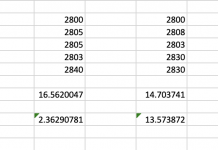I am not trying to be a smart ass and your conclusion is incorrect. to put things in perspective regarding my shooting before I started shooting RFBR I shot groups a lot of groups during all conditions. the reason there was no class for me to shoot local in RFBR I waited 4 years to shoot UL. this was back in 2017 since then I have won our UL club championships 5 consecutive times now. 2021 I set a club record by winning the season before it ended. how I did it was we shoot 12 matches for the season and use the best 7 match scores for the total points. 70 is max points you can earn. I won 7 straight matches nobody did it since they started shooting RFBR over the last 12-14 years. so, by July I had it all wrapped up. that year was also my best and I topped it off by finishing 2nd behind the number one ARA shooter that year. yes, he kicked my butt and beat me by 1100 points, but he beat 3rd and below by 2200 points I beat 3rd and below by 1100 points. there also were two other shooters who finished that year in the top 25 across the nation in ARA.
so, my dues have been earned maybe not in distances past 100yds. but measured by how many ARA matches I have shot since 2017 with 3rd and 5th place being the worst I have finished. in the past 6 years I have shot less than 70 sanctioned ARA targets and I believe in 9 or 10 matches with 5 wins. so, I am not a newbie shooter. just for long distances.
Lee
I figured you had to be a serious BR shooter and BTW congrats on your achievements.
The dedication to be a national level champion I find astounding! The guy who won the national BR N50 is a friend, well more than a acquaintance anyway. He builds Thomas pcp air rifles and he literally shoots enough pellets and slugs/(pure lead swaged bullets) to fill a 5 gallon bucket/a 100,000 or more in a years time so he's shooting and testing many hours a week.
Turns out one can get pretty good in the wind, both in the horizontal and the vertical, with that much trigger time. On top of this he's just a bulldog in personality. Man he don't let go until he's figured things out and its continual in incremental improvements past that. His guns which were totally awesome years ago are much improved over them nowadays.
Being a, I'll use the word "tactical" rifle based forum, the BR world isn't as well known around here.
Story=It was funny one time for me here at SH. Some guy with apparently more money than sense wanted a true 1/4" all day long rifle at 100Y, and about that good at distance, so a/that particular thread ensued after getting a dud of a custom 308 tactical rifle, thus he was now looking for the best of the best.
I suggested he get a Wheeler custom BR rifle in 6mmBRA, and well the other ancillary items needed to achieve such groups on a regular basis. I think one of Wheeler's rifles won 1000Y BR that year but I can't remember exactly, however these were definitely as close to that task as could be had at the time??
What happened is I got flamed by the Fan Bois of top of the line 308 tactical rifle world, LOL. I had absolutely nothing against this smith or his rifles, as well he seems like a great guy, but I was just pointing out what was actually needed to achieve the OP's objective as close as possible.
That being said I'm no BR shooter per say but I can read BR stats and match results.
Another funny thing was that shortly after this, 6mmBR, 6mmDasher, and 6mmBRA, started to become popular in the "nowadays they call it" the (Precision Rifle World).
Don't say "tactical" rifle these days or the dog pile is coming because that's not cool anymore, LOL!
Back to this thread.
IMO the most optimal ammo has every positive attribute we can think of or results go down from there in one way or another. The question is how much, time, effort, and money, does one want to spend to find that special lot#/number of it. Me, nope not gonna go there. What a relief.



